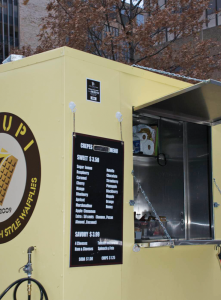
Choupi in Rosslyn
Brittany, located in the northwest region of France, has witnessed the birth of a medley of exquisite French cuisines, including the renowned Brittany cookies, and my personal favorite: crepes. Many characterize the crepe as a distant relative of the pancake, and not without good reason. The two do share almost the same ingredients. The crepe, however, enjoys a longer and richer history than its fluffy, breakfast counterpart.
This French invention first made its appearance around the 12th century, when buckwheat was introduced in Brittany from the distant east. High in fiber, easily digestive protein and essential amino acids, this gluten-free plant thrived in the soil of Brittany. The crepes made from this nutritious buckwheat are called galettes. Dark brown in shade and crispy in texture, modern French galettes are stuffed with savory fillings.
The softer crepes, with which more people are familiar, appeared at the turn of the 20th century with the increased affordability of white wheat flour. In France, white flour crepe is intended for sweet fillings. However, in most other parts of the world, little distinction is made, and white flour crepe is used for both sweet and savory dishes. This is because, unlike galette, white flour crepe is composed of eggs, milk and butter. As a result, it has a delicate texture that is more popular.
Despite their many differences, crepes and galettes are both very thin. “Crepe” means “curled” in Latin, whereas “galette” means “flat cake.” It is this exact feature that opens up all kinds of possibilities for a crepe. Indeed, whereas pancake dishes can be quite limited in variation of flavor and are usually presented as sweeter dishes, crepes are amazingly flexible in terms of fillings. Rather than asking what can be used as a filling, a better question might be, what cannot be put inside a crepe?
Quite close to campus, Cafe Bonaparte (1522 Wisconsin Ave. NW) specializes in crepes and offers a whole page of both sweet and savory versions of the French pancake. In spite of its popularity, I have found this European cafe and its crepes a disappointment. For my entree, I ordered the savory Renoir Crepe. Rolled inside are scrambled eggs and Italian sausage, with green peppers and onions to add flavor. Swiss and cheddar cheese top the crepe, rendering it more enticing in both presentation and taste — at least in theory. In reality however, the combination proved bland and unimpressive. Larraine, the sweet crepe, on the other hand, turned out flavorful enough — perhaps too much so. Melted ice cream and mixed berry sauce just didn’t work well together.
In comparison, the location of Oby Lee (3000 Washington Blvd., Arlington, Va.) is much more remote than that of Cafe Bonaparte. This creperie sports an eye-catching, but not overly ostentatious, shade of red. Much like Cafe Bonaparte, it too has an extensive menu of seemingly delicious crepes. To my delight, the Crepes Benedict that I ordered was impeccable in all regards. Not only were the ingredients fresh and the taste wonderful (it has to be if it resembles a real eggs benedict), but the idea itself was original and creative as well, proving just how flexible crepes can be. Furthermore, the strawberry and banana sweet crepe that my friend ordered came as a wonderfully presented platter, and if the nods and smiles of my friend were any indication, it tasted equally amazing.
Some people have criticized the excessive attention and time given to the decoration of the crepe. For example, with the pattern of whipped cream on top, the sweet crepe loses its most fundamental charm in a creperie. Such is a charm found only in food stands, where crepes are made simple and fresh before your eyes. Although they are not as common as in Paris, high-quality crepe stands can still be tracked down in the D.C. area.
Standing at the crossroad of N Lynn St. and 19th St., Choupi is arguably one of the most convenient and excellent places for breakfast, lunch and even afternoon tea. The Nutella and brownie crepe is meant for chocolate lovers, who cannot help but surrender to the hazelnut spread oozing out of the hot crepe layer. The Jif and banana crepe will no doubt satiate peanut butter fanatics, who cannot help but succumb to the richness and the touch of tropic taste. Crepes on the Walk is another spot that makes relies on quality instead of extravagant ingredients. I ordered the most popular California Brunch Special, and just a final touch of salt and black pepper worked its magic. Although I do not have a sweet tooth and have only tried that one savory crepe, I entertain no doubt about the quality of its more famous sweet crepes.
It is difficult to imagine anyone not being a fan of the crepe, whose infinite possibilities of fillings almost guarantee at least one variation that will appeal to a given person. Luckily, whether one finds a creperie or a food stand to be more tempting, both preferences can be granted around the nation’s capital.
Yiwen Hu is a rising sophomore in the School of Foreign Service. Tastes of the District appears every other Wednesday at thehoya.com.













